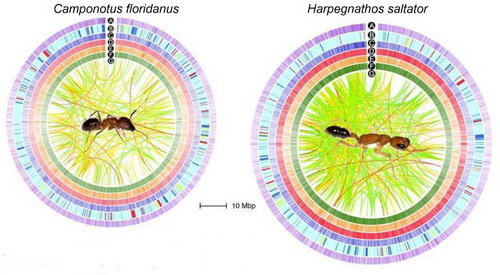
An international team of researchers at Arizona State University, BGI-Shenzhen, Kunming Institute of Zoology (KIZ) of Chinese Academy of Sciences (CAS), New York University School of Medicine, and University of Pennsylvania School of Medicine, reported in this week’s Science the genomes of two ant species:Camponotus floridanusandHarpegnathos saltator.
C. floridanusandH. saltator have very different social organization, caste morphology, behavior, and hunting habit. In organized societies of ants, queens have longer life-span than workers, with an average of 10 times longer than workers’ offspring and up to 500 timeslonger than males.
By comparing the genomes of C. floridanusandH. saltator, and gene expression of different castes and developmental stages, the team identified genes related with aging process, neuronal function and chemical communication. “Our discoveries make ants an attractive model for genomic and epigenetic studies on life-span regulation, behavior and neurobiology.” said Dr Guojie Zhang, the project investigator from BGI-Shenzhen and CAS-KIZ.
de novo sequencing and assembling of the two ants genomes were performed in BGI-Shezhen. Both genomes were sequenced to above100X coverage. The assembled genome size for C. floridanusis 238Mb and forH. saltator 297Mb, each covering more than 90% of the whole genome.
Genomes annotation revealed high amounts of CpG in both genomes at the presence of DNA methylation, implying the specific feature of overrepresented CpG in Hymenoptera. Ant-specific genes were also identified enriched with functions of chemodetection, signal transduction, olfactory as well as detoxification.
Comparison of gene expression in different castes of H. saltator identified in reproductives the up-regulation of telomerase and sirtuin deacetylases, which may associate with the regulation of prolonged life span. Caste-specific expression of microRNAs and SMYD histone methyltransferases were detected in both ants, implicating their roles of caste specification. Many differentially expressed genes in C. floridanusandH. saltator castes are related to neuronal function and chemical communication, such as those with GO terms of “sensory perception of smell”, “Olfactory receptors” and associated with metabolism of hydrocarbons.
On a broader scale, digging down into the ant genome could reveal some of the mechanisms of epigenetic shift themselves. The ant model will provide a way to investigate the role of epigenetic change in development, longevity and behavior
